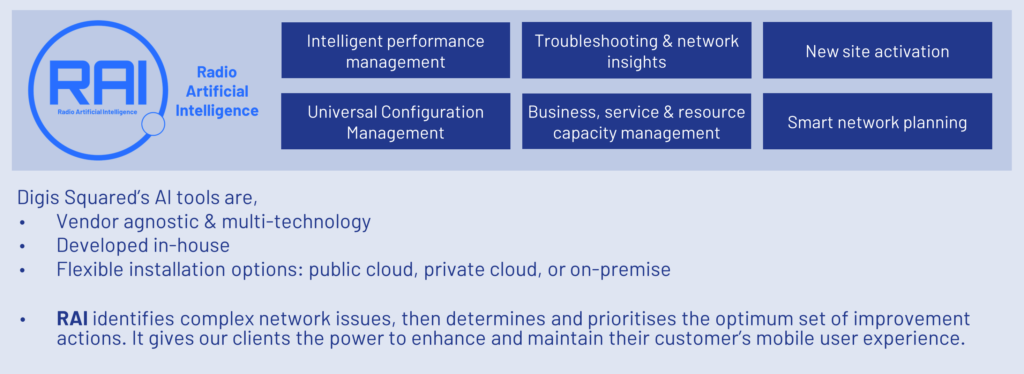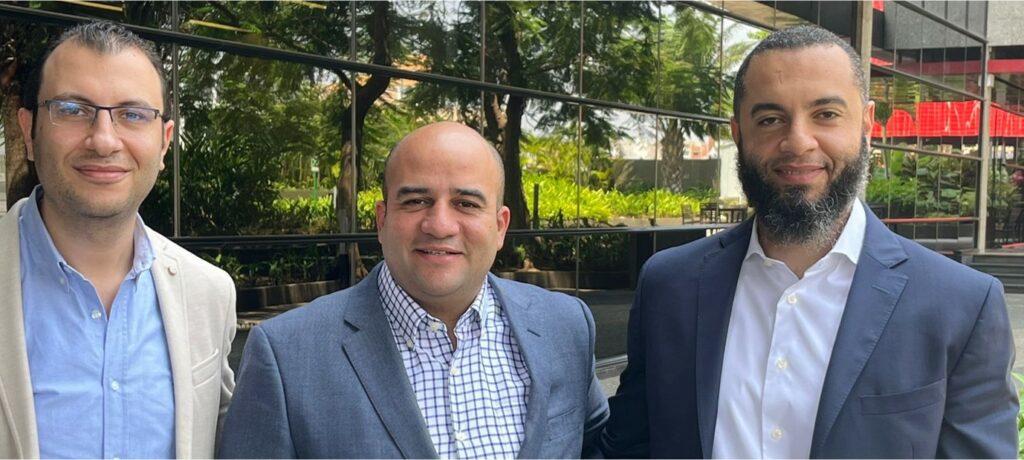
Network Function Virtualization (NFV), is becoming increasingly important as mobile networks are being asked to handle an ever-growing number of connected devices and new use cases. In this article, Amr Ashraf, RAN and Software Solution Architect and Trainer, describes the benefits of NFV, capabilities and deployment considerations. Plus, we take a quick look at how Digis Squared’s powerful AI-tool, INOS, can help in the deployment validation of NFV.
Network Function Virtualization
Mobile virtualization – also known as network function virtualization (NFV) – is a powerful technology that has the capability to transform the way mobile networks are designed, deployed, and operated.
- NFV enables the creation of virtualized mobile networks, and the isolation of different types of traffic on the same physical network infrastructure.
- The creation of different virtual networks for different types of services or different user groups.
- Multiple independent network operators to share a common infrastructure,
- And improves the security of the network.
In this article, Amr Ashraf describes the benefits of NFV, capabilities and deployment considerations. Plus, we take a quick look at how Digis Squared’s powerful AI-tool, INOS, can help in the deployment validation of NFV.
The future of mobile network functions is virtual
Mobile virtualization is becoming increasingly important as mobile networks are being asked to handle an ever-growing number of connected devices and new use cases.
NFV & Infrastructure Sharing. One of the main benefits of mobile virtualization is that it allows for multiple independent network operators to share a common infrastructure. This can help to reduce the costs and complexity of building and maintaining mobile networks, and can also help to improve coverage and capacity in areas where it would otherwise be difficult or expensive to deploy new infrastructure.
NFV & Security. Mobile virtualization also helps to improve the security of the network by isolating different functions and providing a secure environment for each virtual network. This makes it an ideal solution for enterprise customers who need to maintain high levels of security for their sensitive data.
Deployment flexibility. Mobile virtualization is supported by software-based virtualized network functions (VNFs), which can be run on standard servers and storage systems, rather than specialized hardware. This makes it easy to scale and adapt the network to changing requirements. Additionally, it also makes it possible to deploy mobile virtualization solutions in a variety of different environments, including on-premises, in the cloud, or at the edge of the network.
NFV & 5G customisations. It’s worth noting that mobile virtualization is a key technology in building the 5G network. 5G network standards are designed to support network slicing, which can create multiple isolated virtual networks on top of a common physical infrastructure. This makes it possible to create customized solutions for different types of users and use cases, such as providing high-bandwidth services for multimedia applications, or low-latency services for industrial automation and control.
NFV is the future, and the future is now. Mobile virtualization is a rapidly evolving technology with considerable potential to transform the way mobile networks are designed, deployed, and operated. In the coming years, we expect to see more and more operators turning to mobile virtualization to meet the growing demands on their networks and stay competitive in the fast-changing mobile landscape.
Orchestration
Implementing mobile virtualization can present a number of technical challenges, including the management and orchestration of virtualized network functions (VNFs) and ensuring network security. Managing and orchestration of VNFs is a complex task, which involves provisioning and configuring VNFs, as well as ensuring their availability and performance. This is complicated by the fact that VNFs are software-based and can be deployed on a variety of hardware and virtualization platforms.
Security
As VNFs are software-based, they can be targeted by cyber-attacks just like any other type of software. Therefore, ensuring network security is vital when implementing mobile virtualization.
Additionally, virtualized networks may be vulnerable to new types of attacks that exploit the virtualization itself.
NFVO. One of the key solutions to these challenges is the use of network function management and orchestration (NFVO) systems. NFVOs automate the provisioning, configuration, and management of VNFs, and they help to ensure that the VNFs are highly available and perform well. They also play an important role in the orchestration of VNFs, which involves coordinating the actions of multiple VNFs to achieve a desired outcome.
Strong defences. Another key solution is the use of security solutions such as firewall, intrusion detection and prevention systems, secure VPN, and secure containers to protect the virtualized network, secure communication between virtualized functions, and protect virtualized infrastructure from unauthorized access.
Anomaly detection. Solutions based on artificial intelligence and machine learning can also be used to monitor and detect anomalies in the network, identify potential security threats, and take appropriate action to mitigate them.
Digis Squared recommend involving INOS Probe to undertake anomaly detection 24/7, and send these alerts to the CSP. Read more – Anomaly detection: using AI to identify, prioritise and resolve network issues.
Security strategy. In addition to these technical solutions, it’s also important to have a comprehensive security strategy in place to address any potential vulnerabilities and threats that may arise when implementing mobile virtualization. This can include implementing best practices for network design, conducting regular security assessments, and keeping systems and software up to date with the latest security patches and updates.
Skills & expertise. An often overlooked, yet important security consideration, is the need for skilled personnel who are well-versed in the technologies and best practices associated with mobile virtualization. As mobile virtualization is a complex technology that requires a deep understanding of network functions, security, and software development, it’s crucial to have a team of experts who can design, deploy, and maintain secure mobile virtualization solutions.
INOS & NFV
Drive testing can be used to validate the performance of virtualized network functions and ensure that they are providing the desired level of service. This can help to identify and troubleshoot any issues that may arise, such as poor performance or dropped connections. Drive testing can also be used to compare the performance of virtualized network functions with that of traditional, hardware-based network functions, in order to ensure that the virtualized functions are providing an equivalent or better level of service.

Digis Squared’s AI-solution INOS is an essential tool in the implementation and ongoing optimization of NFV. It helps to validate and troubleshoot virtualized network functions and ensure that they are providing an equivalent or better level of service compared to traditional, hardware-based network functions. Additionally, drive testing provides key information about the environment in which the network is deployed that can be used to optimize the deployment of virtualized network functions.
Conclusion
Mobile virtualization is a powerful technology that has the capability to transform the way mobile networks are designed, deployed, and operated. Key benefits it enables include,
- The creation of virtualized mobile networks, and the isolation of different types of traffic on the same physical network infrastructure.
- The creation of different virtual networks for different types of services or different user groups.
- Multiple independent network operators to share a common infrastructure,
- And improves the security of the network.
However, implementing mobile virtualization can present a number of technical challenges, including the management and orchestration of virtualized network functions (VNFs) and ensuring network security.
The use of network function management and orchestration (NFVO) systems, security solutions, AI/ML-based monitoring and anomaly-detection systems, and a comprehensive security strategy can help to mitigate these challenges.
Finally, NFV is a powerful, yet complex technology – it’s essential to work with an experienced team with deep expertise who can design, deploy, and maintain mobile virtualization solutions.
In conversation with Amr Ashraf, Digis Squared’s RAN and Software Solution Architect and Trainer.
If you or your team would like to discover more about our capabilities, please get in touch: use this link or email hello@DigisSquared.com
Find out more about INOS
INOS can be implemented as a public or private cloud, or on-premise solution, and is also available as a “Radio Testing as-a-service” model. Its extensive AI analysis and remote OTA capabilities ensure speedy and accurate assessment of all aspects of network testing: SSV, in-building and drive testing, network optimization and competitor benchmarking, across all vendors, network capabilities and technologies, including 5G, private networks and OpenRAN.
INOS is built with compute resources powered by Intel® Xeon® Scalable Processors. Digis Squared is a Partner within the Intel Network Builders ecosystem program, and a member of the Intel Partner Alliance.
See INOS in action at LEAP, Riyadh & MWC Barcelona
Digis Squared will be at LEAP in Riyadh at the start of February, as part of the UK Pavilion H4.G30, undertaking cloud-based INOS demos. Plus the team will be at MWC Barcelona at the end of February, with a full suite of all the INOS solutions and form factors on a dedicated exhibition stand Hall 7 B13.
Get in touch to arrange a dedicated time to meet: hello@DigisSquared.com

Discover more
- Product update: “Radio Testing as a Service” – successful cloud-based INOS installation in Intel Lab
- Image credits: all images, as stated, and all others are copyright Digis Squared, except first image (abstract light by Maximalfocus).
Digis Squared ◦ Enabling smarter networks.












































